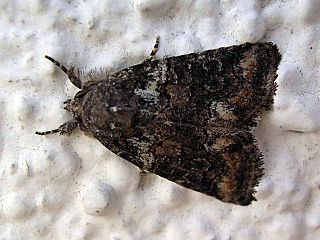
Apamea remissa, the dusky brocade, is a species of moth of the family Noctuidae. It is distributed throughout Europe and Turkey, ranging across the Palearctic realm to Siberia, Manchuria and Japan. It has also been reported from Alaska.

The willowherb hawkmoth is a moth in the family Sphingidae. The species was first described by Peter Simon Pallas in 1772.

Globia sparganii, or Webb's wainscot, is a moth of the family Noctuidae. The species was first described by Eugenius Johann Christoph Esper in 1790. It is found in Europe, Central Asia, from southern Siberia to Manchuria, Korea, Turkey, Syria and Iran.

Orthosia incerta, the clouded drab, is a species of moth of the family Noctuidae, found in Europe and Asia. The occurrence of the species extends through all European countries through the Palearctic to the Russian Far East and Japan. It is absent from northern Fennoscandia and in the Alps it occurs up to 2000 m above sea level.

Hoplodrina blanda is a moth of the family Noctuidae. It is found in the Palearctic realm.

Hada plebeja, the shears, is a moth of the family Noctuidae. It is found in Europe and across the Palearctic to Asia Minor, Armenia, Turkestan, Central Asia, Mongolia, Siberia. Also Kashmir.

Fissipunctia ypsillon, the dingy shears, is a species of moth of the family Noctuidae. It is found in the Palearctic realm.

Bryophila is a genus of moths of the family Noctuidae. The genus was described by Treitschke in 1825.

Chersotis margaritacea is a moth of the family Noctuidae. It is found in Central and Southern Europe up to heights of 1,500 meters. Outside of Europe, it is found in Algeria, Morocco, Anatolia, Iran, Georgia, Armenia, Kazakhstan up to the Altai mountains.

Chersotis cuprea is a moth of the family Noctuidae.

Chersotis multangula is a moth of the family Noctuidae. It is found in the mountainous areas of Central and Southern Europe, Morocco, Turkey, Armenia, Iran, Syria, Lebanon and the Caucasus.

Hadena magnolii is a species of moth of the family Noctuidae. It is found in Morocco, Algeria, south-eastern Europe, Turkey, Israel and Lebanon, Iran, Turkmenistan, Uzbekistan and Kirghizia.

Hadena silenes is a species of moth of the family Noctuidae. It is found in Europe, Turkey, Israel, Iran and Turkmenistan.

Leucania punctosa is a species of moth of the family Noctuidae. It is found from Morocco to Libya, southern Europe, Turkey, Armenia, Israel, Lebanon, Jordan, the Sinai in Egypt, Iran, Iraq and Turkmenistan.

Agrotis trux, the crescent dart, is a moth of the family Noctuidae. The species was first described by Jacob Hübner in 1824. It has a circum-Mediterranean distribution and is found along the coasts of France, Ireland, England, southern Europe, Algeria, Syria, Iraq, Iran, southern Russia and the Arabian Peninsula. In Africa, it is found as far south as South Africa.

Epipsilia latens is a moth of the family Noctuidae. It is found in central Europe, northern Spain, the Apennines, northern Iran, Turkey, Armenia and the Caucasus.

Lithophane lamda, the nonconformist, is a moth of the family Noctuidae. It is found throughout Europe, except in southern Europe. It is also absent from Iceland and Ireland.

Chloantha hyperici, the pale-shouldered cloud, is a moth of the family Noctuidae. It is found in southern Central Europe and from southern Europe to the Near East and Anatolia, Israel, Iraq, the Persian Gulf and the Caucasus, as well as northern Denmark, southern Sweden, southern Norway and south-western Finland.

Aegle semicana is a moth of the family Noctuidae. It was described by Eugenius Johann Christoph Esper in 1798. It is found in Austria, Italy, Hungary, former Yugoslavia, Romania, Bulgaria, Albania, Greece, Turkey, Russia, Libya, Egypt, Syria, Iraq, Iran and Israel, as well as on Sardinia, Sicily, Malta and Cyprus.

Ichneutica scutata is a moth of the family Noctuidae. It is endemic to New Zealand. This species can be found in the southern parts of the North Island as well as the eastern parts of the South Island. It is similar in appearance to I. insignis and I. skelloni but can be distinguished as I. scutata is much paler in appearance. It is likely this species inhabits lowland tussock grasslands as well as coastal dunes although it is not common in inland tussock grasslands. The larvae feed on a variety of herbaceous plants such as Plantago and Convolvulus species, Plagianthus divaricatus. It pupates on soil near its host plants. The adults are on the wing from late March to July.




















